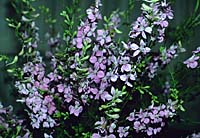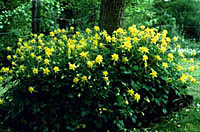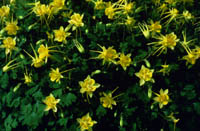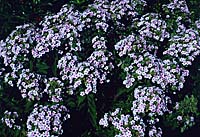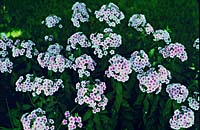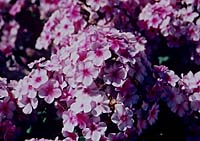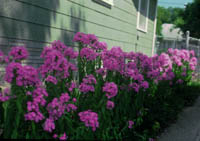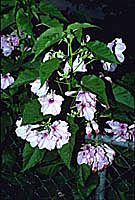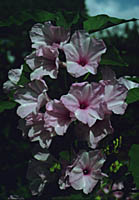
1. Location-specific Turfgrass Selection For Hot & Dry-- Hot & Wet south Texas Growing Conditons
A. Floratam St. Augustine Grass For Shady, Moderate TrafficAreas2. Rodeo Master Gardener Specials for '98Floratam St. Augustine grass was released by the Florida and Texas Agricultural Experiment
Stations in 1972 as a SAD virus and chinch bug resistant selection. It has since been observed to be brown patch tolerant. Like other Florida types, Floratam is a vigorous, coarse textured St. Augustine grass variety. Floratam has a purple stigma color and is sterile. Stolons of Floratam are large, purplish-red in color with internodes averaging 3 inches in length. Leaf blades are wider and longer than common St. Augustine grass. According to James Beard, TAEX Turf Researcher - retired, test at A&M concluded it is the most drought-tolerant of all St. Augustine grasses.
Floratam is not as cold tolerant as the common type found in Texas so preconditioning by use of Winterizer fertilizer (3-1-2 or 4-1-2 ratio) in the fall (October) is CRITICAL. Floratam may suffer freeze damage in areas north (cold) and west (dry) of San Antonio. Floratam also lacks the degree of shade tolerance that other St. Augustine grass varieties possess but filtered light through live oak canopies offer the ideal growth environment.
We believe that the recommended Floratam St. Augustine is the best available for the diverse growing conditions of South Central Texas. It tolerates and even thrives in periods of excessive rainfall. A study of the drought tolerance of grasses entitled: "Comparative Intraspecies and Interspecies Drought Resistance of Six major Warm-Season Turfgrass Species" was conducted by S. I. Sifers and J. B. Beard at Texas A&M University.
Four years of field drought resistance studies were completed on grasses growing on a modified sand root zone.In the fourth year of the study, 29 bermudagrass, 2 seashore paspalum, 2 buffalograss, 8 St. Augustine grass, 6 centipede grass, and 11 zoysiagrass cultivars were subjected to 158 days of progressive water stress with no supplemental irrigations applied and less than 7.5 cm of natural rainfall.Degree of leaf firing was used as an indicator of dehydration avoidance and post-drought shoot recovery was used as the indicator for drought resistance.Significant drought resistance differentials were found across the cultivars and among the species. Results were consistent with the first three years of the study among the bermudagrass, seashore paspalum, St. Augustine grass, and buffalograss cultivars.Among the centipedegrass cultivars only Oklawn fully recovered. Leaf firing of all zoysiagrass cultivars was in excess of 50%. All recovered, except Meyer at 20 percent and Belair at 45% after 30 days.Excellent dehydration avoidance was seen in Floratam and Floralawn St. Augustinegrass. There were large variations in drought resistance among the five St. Augustinegrass cultivars. Floralawn and Floratam showed high green shoot recovery. They showed less than 50% leaf firing after 34 days of drought stress and recoveries of over 90 percent. However, Texas Common and Raleigh St. Augustinegrass as well as Prairie buffalograss showed over 98% leaf firing and less than 20 percent recovery.The performance of Floratam and Floralawn was excellent throughout the study in terms of shoot color, turgidity, and uniformity. They were comparable to 609 Buffalograss.
Funds will be used to support the Youth Gardening Program of the Bexar County Master Gardeners under the direction of Dr. Calvin Finch. Plants will be promoted and advertised in the San Antonio media but not necessarily available in local nurseries A. The new Bexar County Master Gardener determinate (small growing) plant, large cherry tomato (DWARF CHERRY SURPRISE TOMATO) recommended for canning and sauces as well as fresh eating.
- BUNNY-BLOOM LARKSPUR-- Pink-headed Bunny Bloom Larkspur
- JUNIOR PETUNIA: A reseeding annual old-fashioned petunia.More cold tolerant, disease resistant and heat tolerant than modern hybrids. Spreading growth habit with deep lavender, medium size flowers. Space transplants 12 inches apart. Prefers full sun in well-drained, fertile soils. -- the first hybrid, old-fashioned petunia which reseeds itself year after year and blooms from early spring until fall.
- Texas Gold Columbine in 2-inch peat pots for economical columbine establishment
- The new Heading Success Spinach variety -- the first heading spinach
- A new, spectacular Perennial Phlox to join the common magenta pink phlox (Southern Comfort). This yet-to-be-named phlox is longer standing, disease tolerant and begins blooming several weeks after the common phlox. This phlox has darker green, wider leaves and the plant is tidy until fall. The weight of the blooms do not break the plant open as readily as does the common phlox. A new winner for SouthCentral Texas gardeners.
- POSSIBLY -- Ornamental Sweet Potatoes -- White and Maroon foliage
- POSSIBLY --
in 3 inch containers
BUSH MORNING GLORY OR MOONFLOWER
| Return to Index | Go to March |
